Page 117 of 400
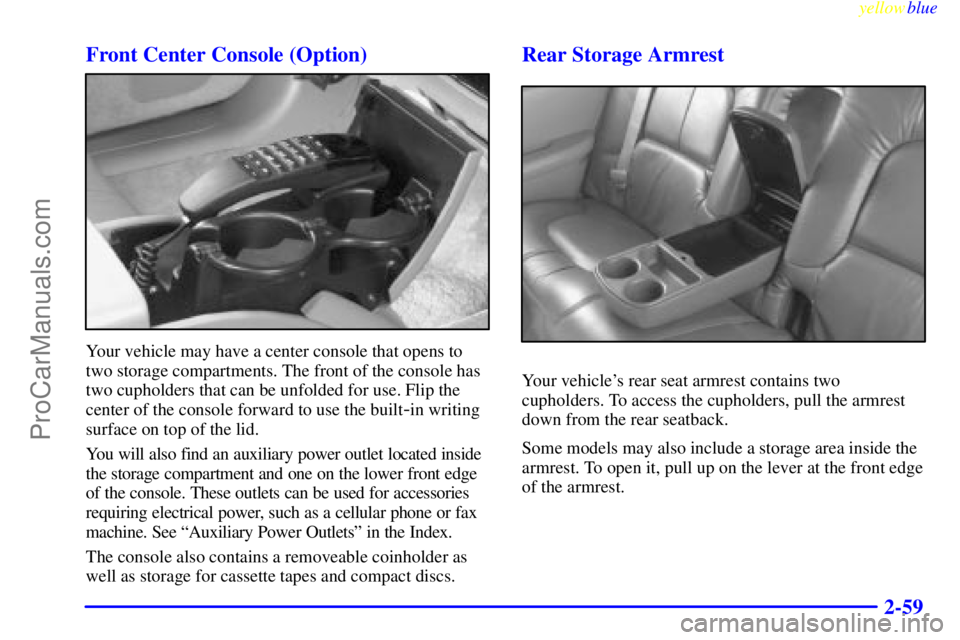
yellowblue
2-59 Front Center Console (Option)
Your vehicle may have a center console that opens to
two storage compartments. The front of the console has
two cupholders that can be unfolded for use. Flip the
center of the console forward to use the built
-in writing
surface on top of the lid.
You will also find an auxiliary power outlet located inside
the storage compartment and one on the lower front edge
of the console. These outlets can be used for accessories
requiring electrical power, such as a cellular phone or fax
machine. See ªAuxiliary Power Outletsº in the Index.
The console also contains a removeable coinholder as
well as storage for cassette tapes and compact discs.
Rear Storage Armrest
Your vehicle's rear seat armrest contains two
cupholders. To access the cupholders, pull the armrest
down from the rear seatback.
Some models may also include a storage area inside the
armrest. To open it, pull up on the lever at the front edge
of the armrest.
ProCarManuals.com
Page 120 of 400
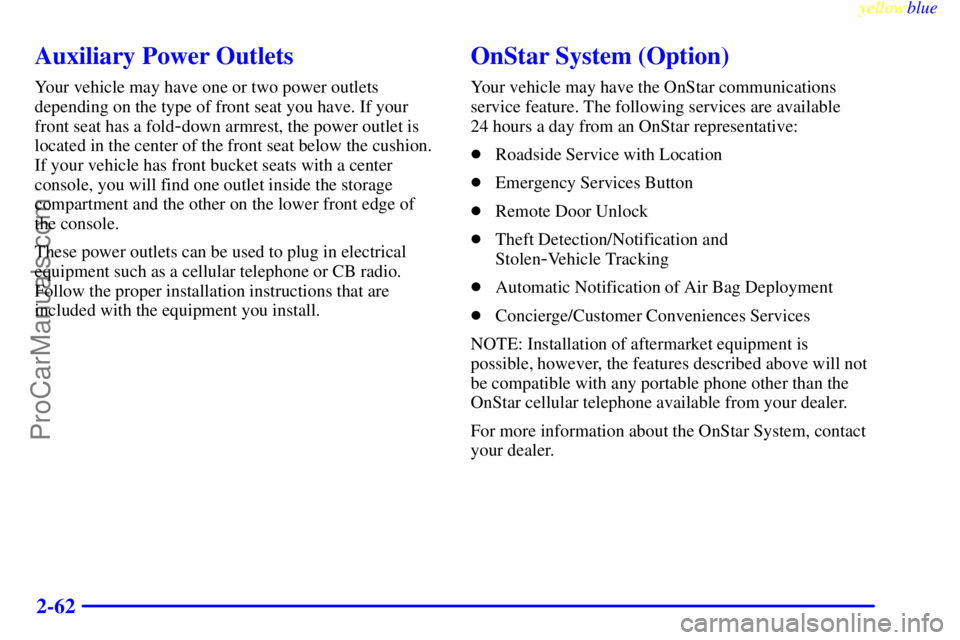
yellowblue
2-62
Auxiliary Power Outlets
Your vehicle may have one or two power outlets
depending on the type of front seat you have. If your
front seat has a fold
-down armrest, the power outlet is
located in the center of the front seat below the cushion.
If your vehicle has front bucket seats with a center
console, you will find one outlet inside the storage
compartment and the other on the lower front edge of
the console.
These power outlets can be used to plug in electrical
equipment such as a cellular telephone or CB radio.
Follow the proper installation instructions that are
included with the equipment you install.
OnStar System (Option)
Your vehicle may have the OnStar communications
service feature. The following services are available
24 hours a day from an OnStar representative:
�Roadside Service with Location
�Emergency Services Button
�Remote Door Unlock
�Theft Detection/Notification and
Stolen
-Vehicle Tracking
�Automatic Notification of Air Bag Deployment
�Concierge/Customer Conveniences Services
NOTE: Installation of aftermarket equipment is
possible, however, the features described above will not
be compatible with any portable phone other than the
OnStar cellular telephone available from your dealer.
For more information about the OnStar System, contact
your dealer.
ProCarManuals.com
Page 185 of 400
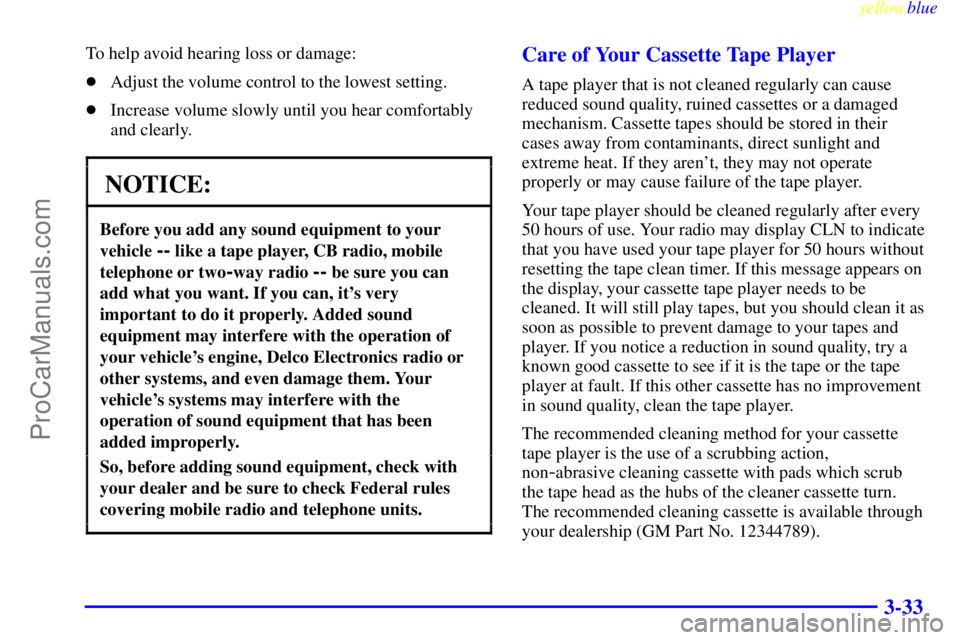
yellowblue
3-33
To help avoid hearing loss or damage:
�Adjust the volume control to the lowest setting.
�Increase volume slowly until you hear comfortably
and clearly.
NOTICE:
Before you add any sound equipment to your
vehicle
-- like a tape player, CB radio, mobile
telephone or two
-way radio -- be sure you can
add what you want. If you can, it's very
important to do it properly. Added sound
equipment may interfere with the operation of
your vehicle's engine, Delco Electronics radio or
other systems, and even damage them. Your
vehicle's systems may interfere with the
operation of sound equipment that has been
added improperly.
So, before adding sound equipment, check with
your dealer and be sure to check Federal rules
covering mobile radio and telephone units.
Care of Your Cassette Tape Player
A tape player that is not cleaned regularly can cause
reduced sound quality, ruined cassettes or a damaged
mechanism. Cassette tapes should be stored in their
cases away from contaminants, direct sunlight and
extreme heat. If they aren't, they may not operate
properly or may cause failure of the tape player.
Your tape player should be cleaned regularly after every
50 hours of use. Your radio may display CLN to indicate
that you have used your tape player for 50 hours without
resetting the tape clean timer. If this message appears on
the display, your cassette tape player needs to be
cleaned. It will still play tapes, but you should clean it as
soon as possible to prevent damage to your tapes and
player. If you notice a reduction in sound quality, try a
known good cassette to see if it is the tape or the tape
player at fault. If this other cassette has no improvement
in sound quality, clean the tape player.
The recommended cleaning method for your cassette
tape player is the use of a scrubbing action,
non
-abrasive cleaning cassette with pads which scrub
the tape head as the hubs of the cleaner cassette turn.
The recommended cleaning cassette is available through
your dealership (GM Part No. 12344789).
ProCarManuals.com
Page 187 of 400
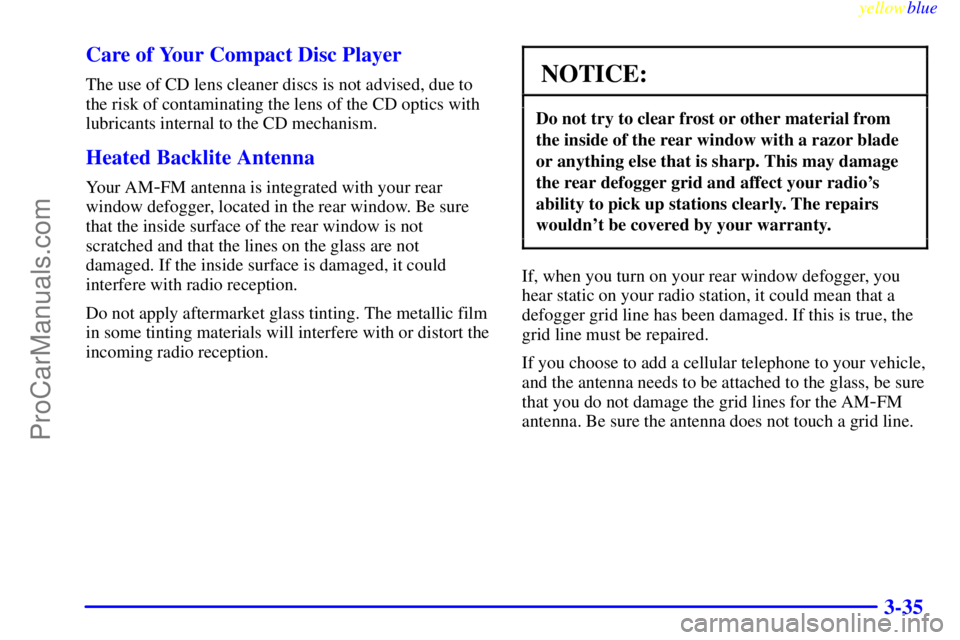
yellowblue
3-35 Care of Your Compact Disc Player
The use of CD lens cleaner discs is not advised, due to
the risk of contaminating the lens of the CD optics with
lubricants internal to the CD mechanism.
Heated Backlite Antenna
Your AM-FM antenna is integrated with your rear
window defogger, located in the rear window. Be sure
that the inside surface of the rear window is not
scratched and that the lines on the glass are not
damaged. If the inside surface is damaged, it could
interfere with radio reception.
Do not apply aftermarket glass tinting. The metallic film
in some tinting materials will interfere with or distort the
incoming radio reception.
NOTICE:
Do not try to clear frost or other material from
the inside of the rear window with a razor blade
or anything else that is sharp. This may damage
the rear defogger grid and affect your radio's
ability to pick up stations clearly. The repairs
wouldn't be covered by your warranty.
If, when you turn on your rear window defogger, you
hear static on your radio station, it could mean that a
defogger grid line has been damaged. If this is true, the
grid line must be repaired.
If you choose to add a cellular telephone to your vehicle,
and the antenna needs to be attached to the glass, be sure
that you do not damage the grid lines for the AM
-FM
antenna. Be sure the antenna does not touch a grid line.
ProCarManuals.com
Page 190 of 400
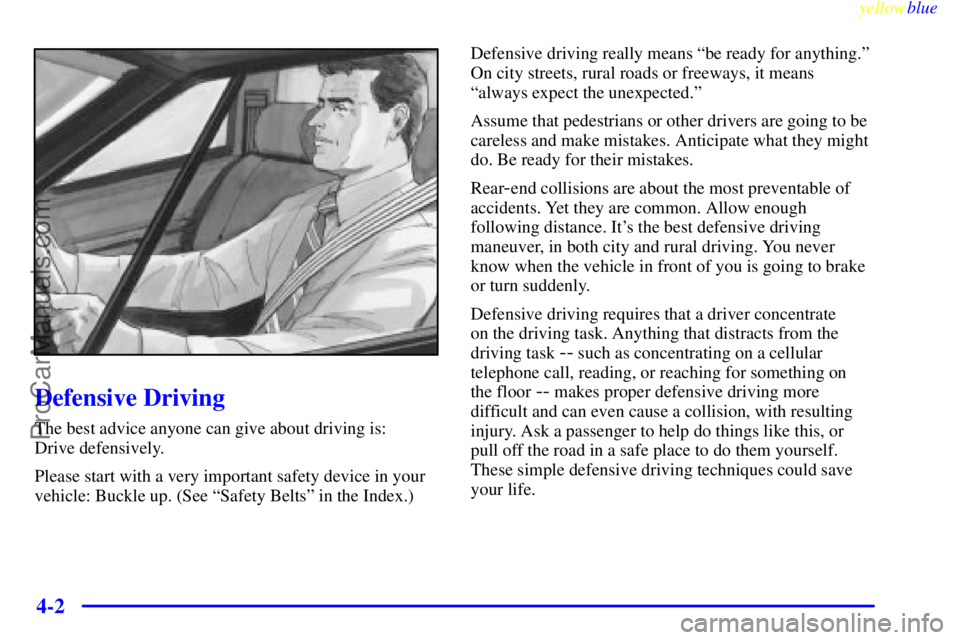
yellowblue
4-2
Defensive Driving
The best advice anyone can give about driving is:
Drive defensively.
Please start with a very important safety device in your
vehicle: Buckle up. (See ªSafety Beltsº in the Index.)Defensive driving really means ªbe ready for anything.º
On city streets, rural roads or freeways, it means
ªalways expect the unexpected.º
Assume that pedestrians or other drivers are going to be
careless and make mistakes. Anticipate what they might
do. Be ready for their mistakes.
Rear
-end collisions are about the most preventable of
accidents. Yet they are common. Allow enough
following distance. It's the best defensive driving
maneuver, in both city and rural driving. You never
know when the vehicle in front of you is going to brake
or turn suddenly.
Defensive driving requires that a driver concentrate
on the driving task. Anything that distracts from the
driving task
-- such as concentrating on a cellular
telephone call, reading, or reaching for something on
the floor
-- makes proper defensive driving more
difficult and can even cause a collision, with resulting
injury. Ask a passenger to help do things like this, or
pull off the road in a safe place to do them yourself.
These simple defensive driving techniques could save
your life.
ProCarManuals.com
Page 207 of 400
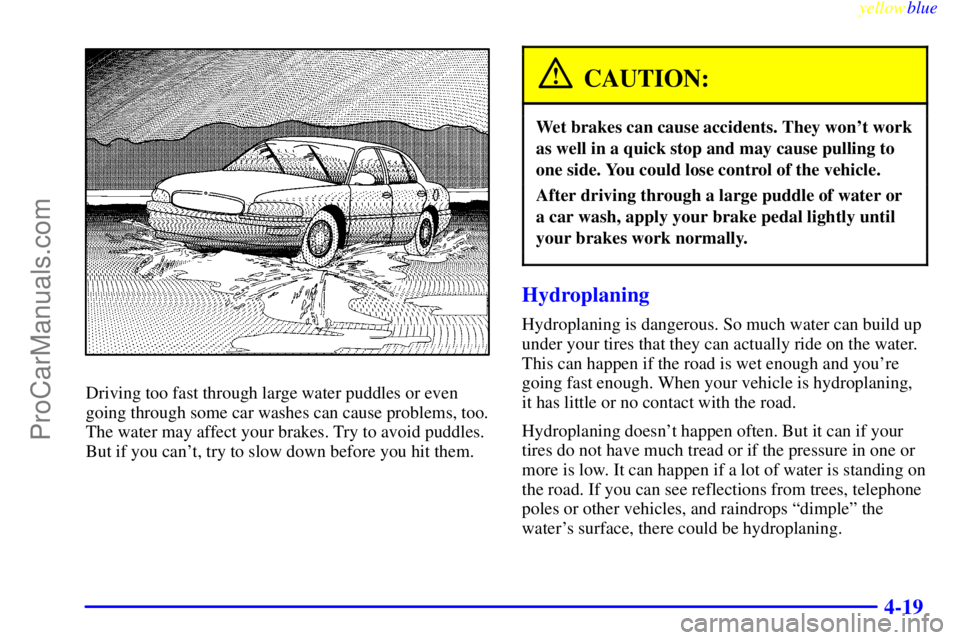
yellowblue
4-19
Driving too fast through large water puddles or even
going through some car washes can cause problems, too.
The water may affect your brakes. Try to avoid puddles.
But if you can't, try to slow down before you hit them.
CAUTION:
Wet brakes can cause accidents. They won't work
as well in a quick stop and may cause pulling to
one side. You could lose control of the vehicle.
After driving through a large puddle of water or
a car wash, apply your brake pedal lightly until
your brakes work normally.
Hydroplaning
Hydroplaning is dangerous. So much water can build up
under your tires that they can actually ride on the water.
This can happen if the road is wet enough and you're
going fast enough. When your vehicle is hydroplaning,
it has little or no contact with the road.
Hydroplaning doesn't happen often. But it can if your
tires do not have much tread or if the pressure in one or
more is low. It can happen if a lot of water is standing on
the road. If you can see reflections from trees, telephone
poles or other vehicles, and raindrops ªdimpleº the
water's surface, there could be hydroplaning.
ProCarManuals.com
Page 331 of 400
yellowblue
6-73
Rear Compartment Fuse Block
Additional fuses are located in the fuse center under the
rear seat.
Position Circuitry
1
Relay
--Heated Backlite to
Rear Grid
2
Relay
--Rap
3
Relay
--Trunk Release to Solenoid
4
Relay
--ELC to CompressorPosition Circuitry
5 Memory Seat Module, Driver Seat
Switch, Driver Lumbar SW
6 ELC Sensor, ELC Compressor
Solenoid
7 Crank
8 Auxiliary Outlet (2 in Cn), Auxil-
iary Outlet (1 in St)
9 PCM/CRU
10 SBM Module
11 Radio/Phone
12 Sunroof
13 Not Used
14 Cell Phone Handset, Cell Phone
Booster, CD Changer
15 Driver Door Module
16 Not Used
17 Amp, Radio Head
18 Driver Heated Seat Module
19 Rear Door Mod (2 LD)
ProCarManuals.com
Page 377 of 400
8-
yellowblue
8-1
Section 8 Customer Assistance Information
Here you will find out how to contact Buick if you need assistance. This section also tells you how to obtain service
publications and how to report any safety defects.
8
-2 Customer Satisfaction Procedure
8
-4 Customer Assistance for Text
Telephone (TTY) Users
8
-4 Customer Assistance Offices
8
-5 GM Mobility Program for Persons
with Disabilities
8
-6 Roadside Assistance
8
-6 Canadian Roadside Assistance
8
-7 Courtesy Transportation8
-8 Warranty Information
8
-9 Reporting Safety Defects to the United
States Government
8
-9 Reporting Safety Defects to the
Canadian Government
8
-10 Reporting Safety Defects to General Motors
8
-10 Ordering Service and Owner Publications
in Canada
ProCarManuals.com